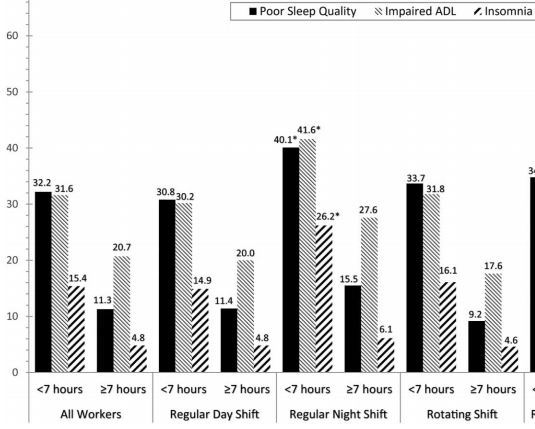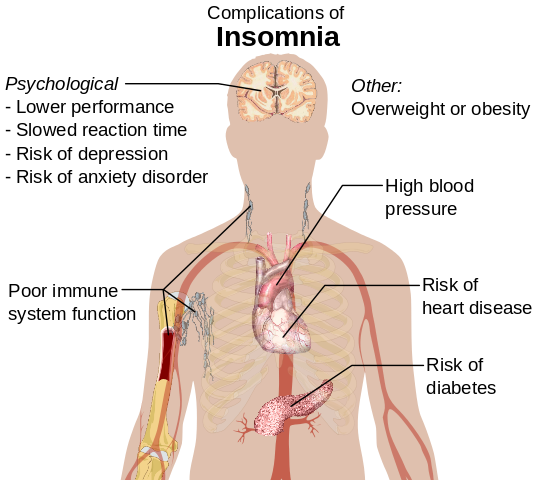Insomnia reduces work performance
Insomnia and the performance of US workers: results from the America insomnia survey - 2011
Sleep. 2011 Sep 1;34(9):1161-71. doi: 10.5665/SLEEP.1230
Kessler RC 1 kessler@hcp.med.harvard.edu, Berglund PA, Coulouvrat C, Hajak G, Roth T, Shahly V, Shillington AC, Stephenson JJ, Walsh JK.
Erratum in Sleep. 2011;34(11):1608., Sleep. 2012 Jun;35(6):725.
 ---
Sleep category starts with
{include}
---
Sleep category starts with
{include}
STUDY OBJECTIVES: To estimate the prevalence and associations of broadly defined (i.e., meeting full ICD-10, DSM-IV, or RDC/ICSD-2 inclusion criteria) insomnia with work performance net of comorbid conditions in the America Insomnia Survey (AIS).
DESIGN/SETTING: Cross-sectional telephone survey.
PARTICIPANTS: National sample of 7,428 employed health plan subscribers (ages 18+).
INTERVENTIONS: None.
MEASUREMENTS AND RESULTS:
Broadly defined insomnia was assessed with the Brief Insomnia Questionnaire (BIQ). Work absenteeism and presenteeism (low on-the-job work performance defined in the metric of lost workday equivalents) were assessed with the WHO Health and Work Performance Questionnaire (HPQ). Regression analysis examined associations between insomnia and HPQ scores controlling 26 comorbid conditions based on self-report and medical/pharmacy claims records. The estimated prevalence of insomnia was 23.2%.
Insomnia was significantly associated with lost work performance due to presenteeism (χ² (1) = 39.5, P < 0.001) but not absenteeism (χ² (1) = 3.2, P = 0.07), with an annualized individual-level association of insomnia with presenteeism equivalent to 11.3 days of lost work performance.
This estimate decreased to 7.8 days when controls were introduced for comorbid conditions.
The individual-level human capital value of this net estimate was $2,280.
If we provisionally assume these estimates generalize to the total US workforce, they are equivalent to annualized population-level estimates of 252.7 days and $63.2 billion.
CONCLUSIONS: Insomnia is associated with substantial workplace costs. Although experimental studies suggest some of these costs could be recovered with insomnia disease management programs, effectiveness trials are needed to obtain precise estimates of return-on-investment of such interventions from the employer perspective.
Clipped from PDF
“The societal burden of insomnia in the United States is substantial, with an estimated one-third of all US adults experiencing weekly difficulties with nighttime sleep and an estimated 50-70 million people complaining of nighttime sleep loss associated with daytime impairment”
",,,very large US national health plan (over 34 million members) who were selected using probability methods that did not oversample subscribers with a
diagnosis of or treatment for insomnia"
- 6% reduced presenteeisme if ALL insomnia could somehow be eliminated
- "If we assume that these associations represent causal effects of insomnia, then complete eradication of insomnia would lead to proportional reductions of between 5.4% (0.2) and 7.8% (0.2) (standard errors of estimated proportions in parentheses) of all the population-level lost work performance due to presenteeism"
This study was cited by 248 later studies as of Oct 2018
Management of Chronic Insomnia Disorder in Adults: A Clinical Practice Guideline From the American College of Physicians - July 2016,
- 10.7326/M15-2175 free PDF online, The word VITAMIN does not occur once in the PDF
Sleep problems and work injuries: A systematic review and meta-analysis - Feb 2014,
- https://doi.org/10.1016/j.smrv.2013.01.004 free PDF
Health economics of insomnia treatments: The return on investment for a good night's sleep - Dec 2016,
- PDF is available free at Sci-Hub 10.1016/j.smrv.2015.11.004
Prioritizing sleep for healthy work schedules - 2012
- https://doi.org/10.1186/1880-6805-31-6 free PDF online
The relationship between sleep and work: A meta-analysis - 2017
http://dx.doi.org/10.1037/apl0000169
"Analyses revealed that both sleep quality and sleep quantity associated negatively with workload and a number of health, attitudinal, and affective outcomes"
Sleep-related problems in the US working population: prevalence and association with shiftwork status - Aug 2016
- " Results The prevalence of short sleep duration (37.6% overall) was highest among night shift workers (61.8%; p<0.001).
- The prevalence of poor sleep quality was 19.2% among all workers, with the highest prevalence among night shift workers (30.7%, p=0.004).
- The prevalence of impaired ADL score (24.8% overall) and insomnia (8.8% overall) was also highest for night shift workers (36.2%, p=0.001 and 18.5%, p=0.013, respectively).
- 📄 Download the PDF from VitaminDWiki

Insomnia Wikipedia
"Between 10% and 30% of adults have insomnia at any given point in time and up to half of people have insomnia in a given year."
3 types: Transient, Acute. Chronic

